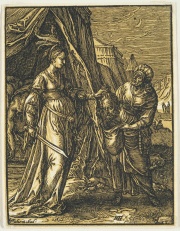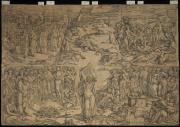Difference between revisions of "Line block"
(username removed) |
(username removed) |
||
| Line 2: | Line 2: | ||
== Description == | == Description == | ||
| − | Any relief etch block or print made from a chemically or mechanically produced printing surface. One line block example, gillotage, is a [http://cameo.mfa.org/materials/fullrecord.asp?name=zinc zinc] printing plate made using a lithographic transfer. One photo-relief etching method involved developing a negative directly on a zinc plate coated with [http://cameo.mfa.org/materials/fullrecord.asp?name=bichromated | + | Any relief etch block or print made from a chemically or mechanically produced printing surface. One line block example, gillotage, is a [http://cameo.mfa.org/materials/fullrecord.asp?name=zinc zinc] printing plate made using a lithographic transfer. One photo-relief etching method involved developing a negative directly on a zinc plate coated with [http://cameo.mfa.org/materials/fullrecord.asp?name=bichromated%20gelatin bichromated gelatin]. After the image is developed, the soluble [http://cameo.mfa.org/materials/fullrecord.asp?name=gelatin gelatin] is washed away and the remaining gelatin is coated with powdered [http://cameo.mfa.org/materials/fullrecord.asp?name=asphaltum asphaltum] to produce an acid-resistant negative image. Other variations include stereotype line block, electrotype line block, and transfer line block. |
[[File:2004.629-SC24141.jpg|thumb|]] | [[File:2004.629-SC24141.jpg|thumb|]] | ||
| Line 11: | Line 11: | ||
== Authority == | == Authority == | ||
| − | * | + | * Luis Nadeau, ''Encyclopedia of Printing, Photographic, and Photomechanical Processes'', Atelier, New Brunswick, 1997 |
| − | * | + | * B. Gascoigne, ''How to Identify Prints'', Thames & Hudson, London, 2004 |
[[Category:Materials database]] | [[Category:Materials database]] | ||
Revision as of 06:31, 24 July 2013
Description
Any relief etch block or print made from a chemically or mechanically produced printing surface. One line block example, gillotage, is a zinc printing plate made using a lithographic transfer. One photo-relief etching method involved developing a negative directly on a zinc plate coated with bichromated gelatin. After the image is developed, the soluble gelatin is washed away and the remaining gelatin is coated with powdered asphaltum to produce an acid-resistant negative image. Other variations include stereotype line block, electrotype line block, and transfer line block.
Synonyms and Related Terms
relief etching; zinc etching; gillotage; stereotype line block; electrotype line block; transfer line block; Strich-Druckstock (Deut.); Druckplatte (Deut.)
Authority
- Luis Nadeau, Encyclopedia of Printing, Photographic, and Photomechanical Processes, Atelier, New Brunswick, 1997
- B. Gascoigne, How to Identify Prints, Thames & Hudson, London, 2004

